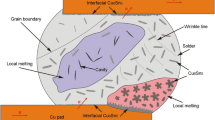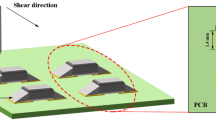Abstract
In this study, in situ investigation of the coupling damage mechanisms of SnAgCu/Cu solder joints under thermal cycling and current was carried out to compare the thermal fatigue under the same temperature range, and to analyze the influence of temperature. It was found that the current increased the temperature of the solder joint, making it obviously higher than the ambient temperature. On the other hand, there was little difference between the thermal–electrical coupling damage and thermal fatigue before a significant increase in solder temperature; the interfacial plastic deformation was only slightly more serious, and the electromigration was not significant. With an increasing number of thermal cycles, the damage, resistance, and temperature of the solder joint increased, and the plastic deformation resistance of the solder decreased, leading to further damage and temperature increase, exhibiting an accelerating damage process. After the temperature reached a certain degree, the solder softened significantly, and its deformation behavior was similar to that of high-viscosity fluids, resulting in surface unevenness with significant height differences. As the temperature of the solder joint increased, the electromigration of Cu in the solder gradually increased, and the migration rate was dominated by the solder grain orientation. With higher peak temperature of the ambient thermal cycle, the thermal cycling–electric current coupling damage rate increased substantially.
Graphical Abstract










Similar content being viewed by others
References
Y. Li and C.P. Wong, Recent advances of conductive adhesives as a lead-free alternative in electronic packaging: materials, processing, reliability and applications. Mater. Sci. Eng. R 51, 1 (2006).
M. Abtew and G. Selvaduray, Lead-free solders in microelectronics. Mater. Sci. Eng. R 27, 95 (2000).
S.V. Garimella, A.S. Fleischer, J.Y. Murthy, A. Keshavarzi, R. Prasher, C. Patel, S.H. Bhavnani, R. Venkatasubramanian, R. Mahajan, Y. Joshi, B. Sammakia, B.A. Myers, L. Chorosinski, M. Baelmans, P. Sathyamurthy, and P.E. Raad, Thermal challenges in next-generation electronic systems. IEEE. Trans. Compon. Pack. Technol. 31, 801 (2008).
B. Agostini, M. Fabbri, J.E. Park, L. Wojtan, J.R. Thome, and B. Michel, State of the art of high heat flux cooling technologies. Heat Transf. Eng. 28, 258 (2007).
F.Q. Lang, H. Yamaguchi, H. Ohashi, and H. Sato, Improvement in joint reliability of SiC power devices by a diffusion barrier between Au-Ge solder and Cu/Ni(P)-metalized ceramic substrates. J. Electron. Mater. 40, 1563 (2011).
V. Samavatian, H. Iman-Eini, Y. Avenas, and M. Samavatian, Thermomechanical fatigue damage model of a solder joint in electronic devices: an interval arithmetic based approach. J. Electron. Mater. 51, 5376 (2022).
T.L. Shao, S.W. Liang, T.C. Lin, and C. Chen, Three-dimensional simulation on current-density distribution in flip-chip solder joints under electric current stressing. J. Appl. Phys. 98, 044509 (2005).
D.A. Shnawah, M.F.M. Sabri, and I.A. Badruddin, A review on thermal cycling and drop impact reliability of SAC solder joint in portable electronic products. Microelectron. Reliab. 52, 90 (2012).
H. Qi, N.M. Vichare, M.H. Azarian, and M. Pecht, Analysis of solder joint failure criteria and measurement techniques in the qualification of electronic products. IEEE. Trans. Compon. Pack. Technol. 31, 469 (2008).
T.C. Chen, M.J.C. Opulencia, H.S. Majdi, A.T. Hammid, H. Sharma, S. Sajjadifar, and A. Surendar, Estimation of thermomechanical fatigue lifetime of ball grid solder joints in electronic devices using a machine learning approach. J. Electron. Mater. 51, 3495 (2022).
Q.K. Zhang and Z.F. Zhang, Thermal fatigue behaviors of Sn-4Ag/Cu solder joints at low strain amplitude. Mater. Sci. Eng. A 2013, 374 (2013).
J. Han, F. Guo, and J.P. Liu, Early stages of localized recrystallization in Pb-free BGA solder joints subjected to thermomechanical stress. J. Alloys Compd. 704, 574 (2017).
Q.K. Zhang and Z.F. Zhang, In situ observations on creep fatigue fracture behavior of Sn-4Ag/Cu solder joints. Acta Mater. 59, 6017 (2011).
P. Borgesen, L. Wentlent, S. Hamasha, S. Khasawneh, S. Shirazi, D. Schmitz, T. Alghoul, C. Greene, and L. Yin, A mechanistic thermal fatigue model for SnAgCu solder joints. J. Electron. Mater. 47, 2526 (2018).
X. Linares, C. Kinney, K.O. Lee, and J.W. Morris Jr., The influence of Sn orientation on intermetallic compound evolution in idealized Sn-Ag-Cu 305 interconnects: an electron backscatter diffraction study of electromigration. J. Electron. Mater. 43, 43 (2014).
M.L. Huang, J.F. Zhao, Z.J. Zhang, and N. Zhao, Role of diffusion anisotropy in β-Sn in microstructural evolution of Sn-3.0Ag-0.5Cu flip chip bumps undergoing electromigration. Acta Mater. 100, 98 (2015).
C.W. An, Q.K. Zhang, and Z.L. Song, High temperature thermal-electrical coupling damage mechanisms of SnAgCu/Cu solder joints. J. Electron. Mater. 52, 3807 (2023).
J. Han, Y. Wang, S.H. Tan, and F. Guo, Effects of grain orientation on Cu6Sn5 growth behavior in Cu6Sn5-reinforced composite solder joints during electromigration. J. Electron. Mater. 47, 1705 (2018).
A. Zamiri, T.R. Bieler, and F. Pourboghrat, Anisotropic crystal plasticity finite element modeling of the effect of crystal orientation and solder joint geometry on deformation after temperature change. J. Electron. Mater. 38, 231 (2009).
R.S. Sidhu and N. Chawla, Thermal fatigue behavior of Sn-rich (Pb-free) solders. Metall. Mater. Trans. A 39A, 799 (2008).
Y.L. Chen, F. Li, K. Li, X. Li, M. Liu, and G. Liu, Thermal fatigue reliability improvement of leadless ceramic chip carrier solder joints. Microelectron. Reliab. 132, 114532 (2022).
A.R. Geranmayeh, R. Mahmudi, and M. Kangooie, High-temperature shear strength of lead-free Sn-Sb-Ag/Al2O3 composite solder. Mater. Sci. Eng. A 528, 3967 (2011).
M.H. Heo, D.H. Lee, M.S. Jeong, and J.W. Yoon, Effects of shear test temperatures and conditions on mechanical properties of Sn-Ag flip-chip solder bumps. J. Mater. Sci. Mater. Electron. 33, 10002 (2022).
H.C. Yang and T.C. Chiu, A unified viscoplastic model for characterizing the softening behavior of the Sn3.0Ag0.5Cu solder under monotonic and cyclic loading conditions. Microelectron. Reliab. 119, 114086 (2021).
M.S. Jeong, D.H. Lee, and J.W. Yoon, Effect of temperature on shear properties of Sn-3.0Ag-0.5Cu and Sn-58Bi solder joints. J. Alloys Compd. 903, 163987 (2022).
R. Valette, E. Hachem, M. Khalloufi, A.S. Pereira, M.R. Mackley, and S.A. Butler, The effect of viscosity, yield stress, and surface tension on the deformation and breakup profiles of fluid filaments stretched at very high velocities. J. Non-Newton. Fluid. 263, 130 (2019).
H. Feng and L.Y. Jiang, Phase field modeling on fracture behaviors of elastomers considering deformation-dependent and damage-dependent material viscosity. Eng. Fract. Mech. 292, 109621 (2023).
Acknowledgments
This work was financially supported by the National Natural Science Foundation of China (52001317), the “Scientific and Technological Innovation 2025” Major Special Project of Ningbo City (2020Z039 and 2021Z049).
Author information
Authors and Affiliations
Corresponding author
Ethics declarations
Conflict of interest
We declare that we have no financial or personal relationships with other people or organizations that can inappropriately influence our work, and there is no professional or other personal interest of any nature or kind in any product, service and/or company that could be construed as influencing the position presented in, or the review of, the manuscript entitled.
Additional information
Publisher's Note
Springer Nature remains neutral with regard to jurisdictional claims in published maps and institutional affiliations.
Rights and permissions
Springer Nature or its licensor (e.g. a society or other partner) holds exclusive rights to this article under a publishing agreement with the author(s) or other rightsholder(s); author self-archiving of the accepted manuscript version of this article is solely governed by the terms of such publishing agreement and applicable law.
About this article
Cite this article
Zhang, Q.K., An, C.W. & Song, Z.L. Thermal Cycling–Electric Current Coupling Damage Mechanisms of SnAgCu/Cu Solder Joints Under Different Temperature Ranges. J. Electron. Mater. 53, 2544–2553 (2024). https://doi.org/10.1007/s11664-024-10975-4
Received:
Accepted:
Published:
Issue Date:
DOI: https://doi.org/10.1007/s11664-024-10975-4




